THE CASE
Mr. Opio is an agricultural coordinator at UWEZO, a local NGO, in Soroti, Eastern Uganda. UWEZO initially managed only human health promotion programs in the region; however, they soon realized that most of the beneficiaries of the HIV and AIDS projects needed a secure food source all year. This was to ensure that medication was not being taken on an empty stomach. An agricultural project focusing on food security was born. Cassava was chosen because of its popularity in the region, as well as its ability to tolerate drought and be stored in the ground for long periods (Figure 2). Since then, the agriculture project has grown and currently provides cuttings for its beneficiaries as well as linking them to other entrepreneurial groups that can help them add value to cassava, such as producing high-quality cassava flour for baking, chips for animal feed, and cassava cuttings for sale as seed (Figure 3A and
3B). UWEZO has established seed multiplication blocks with an initial seed stock obtained from the local agricultural research center. This cassava cultivar was high-yielding and resistant to cassava mosaic disease (CMD), an endemic viral disease in the region.
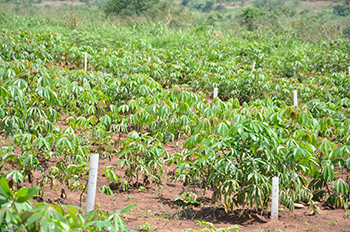
Figure 2. Young cassava plants growing in the field.
Figure 3A.Cassava utilization, Cassava chips. |
Figure 3B.Cassava utilization, Cassava flour. |
Neema has been a client at UWEZO for several years. She has personally seen the benefits of cassava for food security, especially a few years ago when there was a drought. Following that, she convinced other members of her group to plant this improved variety from UWEZO because it was higher yielding and resistant to cassava mosaic disease (CMD). They could also harvest extra tubers to improve and sell. CMD was a problem previously, but yields have stabilized since growers began planting CMD-resistant varieties.
One afternoon, Neema sends her 15-year-old son Lucas to the farm to harvest a few roots of cassava (Figure 4) to boil for their lunch Lucas takes an unusually long time and then returns to report that he had tried about ten plants and most of them seem to have rotten and inedible roots. Neema grabs the hoe and runs to the farm to confirm her son’s claims. Sure enough, after digging up several plants she observes the same situation. Suddenly, the CMD-resistant varieties that she has been planting are now getting diseased and producing rotten tubers. This means that she will not produce enough food for her children, let alone be able to keep any surplus for adding value or selling. The problem is even bigger: several other members of the self-help group are finding rotten cassava roots on their farms.
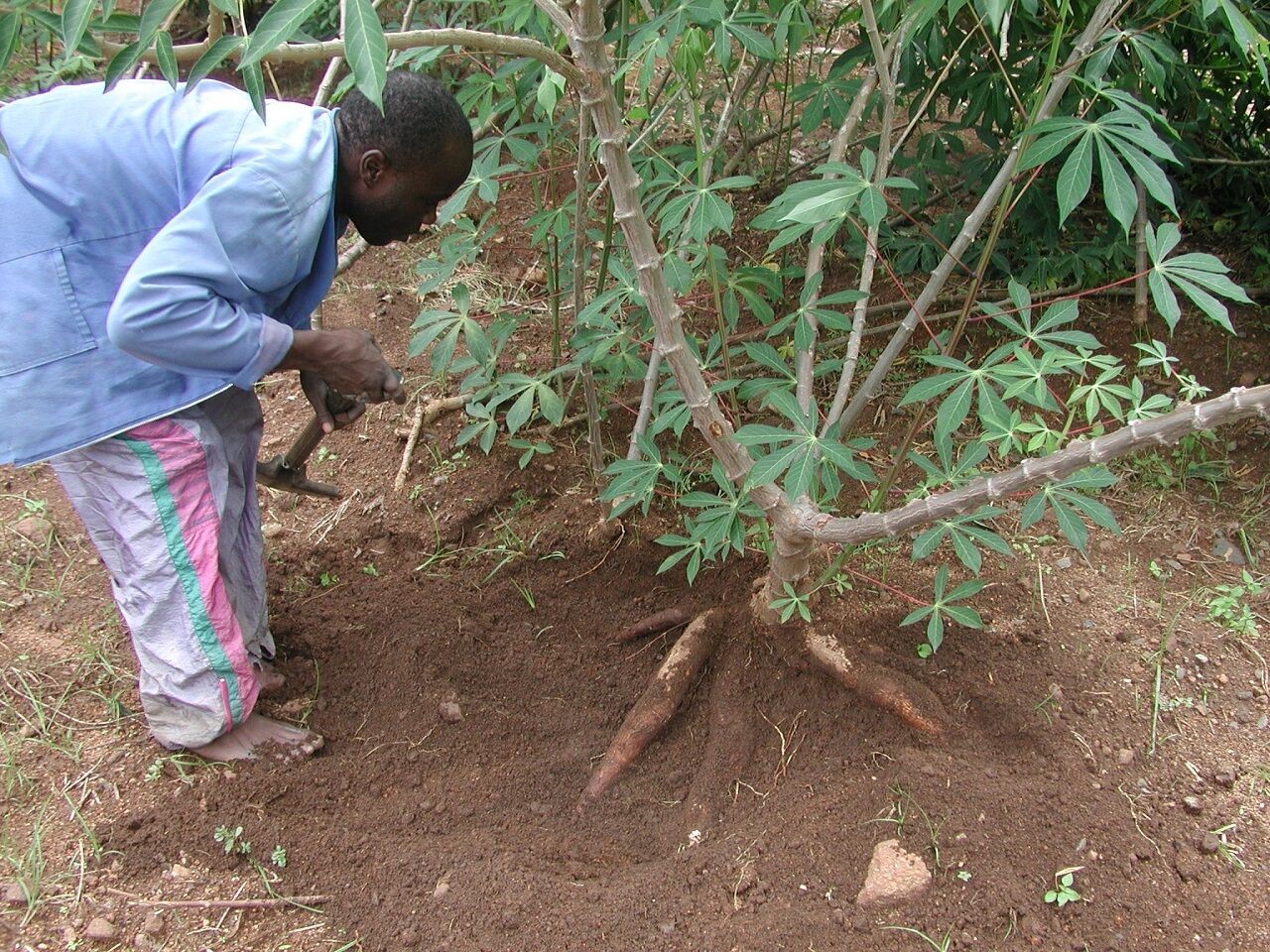
Figure. 4. Harvesting cassava roots
Soon after this, Neema talks to her neighbor, Opolot, who is growing another cassava variety from cuttings he brought from his daughter’s farm. Opolot remembers noticing a few roots producing similar symptoms to those Neema described at harvest, but his plants had less severe symptoms than those from Neema’s farm. Since the problem seems widespread in the village, Neema promises to contact Mr. Opio at UWEZO and report back to Opolot.
In distress, Neema takes a few roots and stems to Mr. Opio’s office at UWEZO. She is understandably upset at the situation after having waited a year to begin harvesting this cassava crop. She explains how she planted cassava in batches every 3 months to ensure a steady supply, and now it seems that she could lose most of it. She threatens to report the NGO to the local administrative officer (the area chief). She also wants to mobilize her self-help group and others in the village to boycott the NGO’s programs.
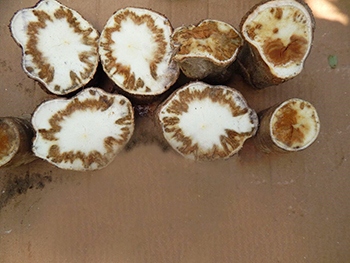
| |
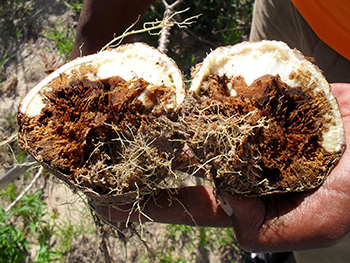 |
Figures 5A and 5B. Symptoms of CBSD on cassava roots. |
| |
Figure 6.Symptoms of CBSD on cassava
stems. |
Figure 7.
Leaf symptoms of cassava mosaic
disease (CMD). |
Neema shows the roots to Mr. Opio. Most of them have a dark brown, hard rot inside (Figures
5A and
5B). She further explains that she had observed that some roots had constrictions (poor quality tuberous roots that have narrower sections). Mr. Opio looks at the stems and notices that the tissue between the nodes seems to be purplish in color, drying up and dying (Figure 6). Neema had not observed the typical CMD symptoms of leaf chlorosis (yellowing) and distorted leaf blades (Figure 7) on any plants during the past year. In contrast, her leaves had mild chlorosis and no distortion (Figures
8A and
8B) and were different from leaf symptoms caused by cassava green mite (CGM) feeding (Figure 9) or nutrient deficiency (Figure 10). Mr. Opio calms Neema and promises her that he will consult Dr. Adungosi at the agricultural research center in Soroti. They would then visit Neema’s farm and interview her as well as several of her neighbors and group members and see how best to resolve the crisis.
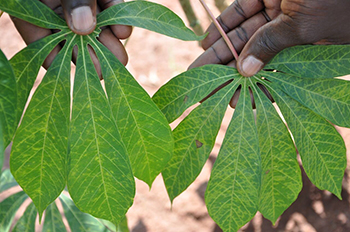
| |
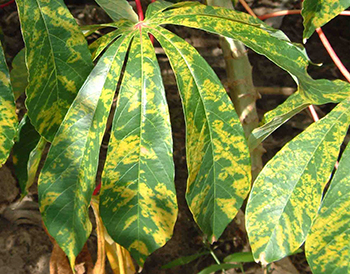 |
Figures 8A and 8B. Symptoms of CBSD on cassava leaves. |
| |
Figure 9.
Symptoms of cassava green mite
(CGM) feeding damage on cassava leaves. |
Figure 10.
Leaf showing yellowing caused
by cassava nutrient deficiency. |
Mr. Opio is also unsure what the problem is and is very sad because of the devastation the disease is causing. He is worried because of the extent to which farmers in this location have adopted and planted this particular CMD-resistant variety in the years that followed the peak of the CMD epidemic. He feels worse because he is well aware of several cassava cutting distribution campaigns by UWEZO to promote CMD-resistant varieties. He understands how much effort leaders of self-help groups like Neema have devoted to ensuring the success of these campaigns. Above all, he is afraid that UWEZO could be blamed for promoting and distributing diseased cassava cuttings.
When Dr. Adungosi examines the rotten root samples from Neema’s farm, she quickly diagnoses it as cassava brown streak disease (CBSD), a disease that was last reported from the area decades ago. Clearly, there is a re-emergence of the deadly disease in the area. It turns out that the CMD-resistant variety that Neema and her neighbors have been growing is highly susceptible to CBSD. CBSD is spread either by a whitefly vector (a vector is a living organism that spreads disease) or by planting infected cuttings. She visits several farms including Neema’s and Opolot’s and interviews the farmers to learn their sources of planting material. She is accompanied by Lance, an American undergraduate student who is on internship at NARO, to survey the extent of the problem. Dr. Adungosi is disturbed by the potentially large impact of the problem they must confront. She requests the local chief to help convene a farmer awareness meeting where she explains to the farmers what the problem is, and how to recognize and manage it. In this meeting, she intends to absolve UWEZO from possible blame.
QUESTIONS AND PROBLEMS TO REFLECT ON:
- What are the major symptoms of CBSD?
- How is CBSD spread?
- How can it be managed?
- Is Neema responsible for the disease? What explanation could she offer her self-help group members?
- Why do you think the symptoms on Opolot’s cassava are less severe than those of Neema and her neighbors?
- What should Dr. Adungosi advise Mr. Opio, Neema, and her neighbors to do?
- Dr. Adungosi asks Lance to prepare a report about the situation for a journalist at a local newspaper and for his university newspaper. What should the reports include?
